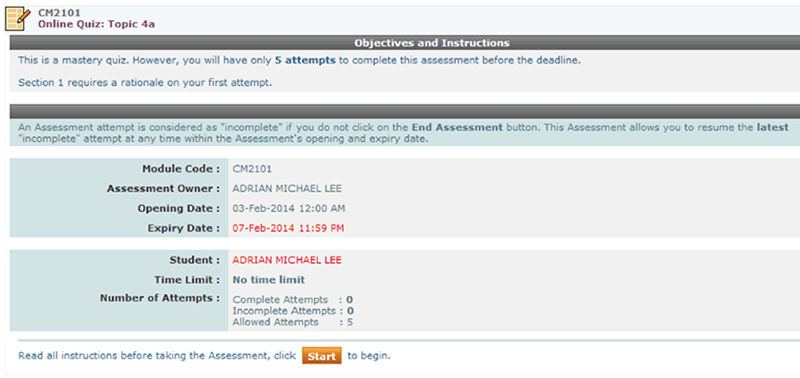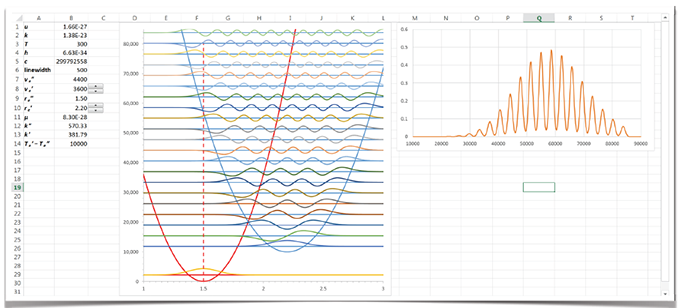Technology in Pedagogy, No. 20, April 2014
Written by Kiruthika Ragupathi
Download
Introduction
What is scaffolding? How does it help learning? Can technology be used? Does it work? And who is Vygotsky? These were the questions that Adrian Lee, a senior lecturer in the Department of Chemistry at the National University of Singapore set out to answer in this session on “Virtually Vygotsky: Using Technology to Scaffold Student Learning”. Through this session, Adrian showcased technologies that can be used before, during and after class to provide appropriate scaffolding to students.
Scaffolding, he says, can come in a variety of forms, from increasing engagement, providing alternate learning strategies, resolving learning bottlenecks, and (paradoxically) taking away support to allow students to master material, among other things. The Zone of Proximal Development (ZPD) underpins some of the ideas of constructivism, and according to Vygotsky (1978), “the actual developmental level characterizes mental development retrospectively, while the Zone of Proximal Development characterizes mental development prospectively.” Vygotsky believed that when a student is at the ZPD for a particular task, providing the appropriate guidance (scaffolding) will give the student enough of a “boost” to achieve the task.
The term ‘scaffolding’, coined by Bruner, was developed as a metaphor to describe the type of assistance offered by a teacher or more competent peer to support learning. In the process of scaffolding, the teacher helps student master a task or concept that the student is initially unable to grasp independently. The teacher then offers assistance with only those skills that are beyond student’s capability. Once the student masters the task with the benefit of scaffolding, the scaffolding can then be removed and the student will then be able to complete the task again on his own. Therefore, what is of great importance is enabling the student to complete as much of the task as possible, unassisted (Wood et al, 1976). How this translates to the constructivist approach is that the area of guidance grows as we teach the subject matter, and as the students mastery level of the subject concepts changes. The model of instructional scaffolding can be illustrated as below:
Adrian also emphasized on the seven principles of undergraduate education by Chickering and Gamson (1987) that is still incredibly pertinent in today’s teaching.
- Encourages contacts between faculty and students
- Develops reciprocity and cooperation among students
- Uses active learning techniques
- Gives prompt feedback
- Emphasizes time on task
- Communicates high expectations
- Respects diverse talents and ways of learning
It is these principles, he said, that shapes his teaching and helps him decide on when and how to provide the much needed scaffolding for his students’ learning.
Note:
For more information on how to use IVLE to implement the 7 principles of effective teaching, please see: http://www.cdtl.nus.edu.sg/staff/guides/ivle-tip-sheet-2.pdf
Scaffolding student learning through technology
Adrian illustrated some technologies that he uses to scaffold student learning, some of which he highlighted were available within IVLE. The first five items are those that are used outside the classroom while the last item is a technology that is used inside the classroom.
1. Lesson plan
He explained that he uses IVLE lesson plan to connect all the instructional resources for the module, and as a one-stop location for students to access these resources. He uses the topic approach compared to the commonly adopted weekly approach, as the topic approach can easily act as an index of his lecture notes and remains accurate on a year-to-year basis as it is independent of changing national holidays.
Five to six different concepts are covered each week. Each topic in the lesson plan usually consists of:
- Play-lists – to allow students to access the online lectures in the recommended sequence before the face-to-face lessons
- Weblinks – to provide additional materials, wherever necessary, to enhance student understanding
- Online quizzes – to test student understanding of concepts. Each quiz consists of about 10 MCQ or “fill-in-the-blank” questions
- Multimedia tutorials – to support the various class exercises through tutorials that discuss the concepts
- Spreadsheets – to enable students to work out problems, thereby boosting understanding through interactive visualizations
A sample lesson plan for one topic is shown below:
2. Online quizzes
Online quizzes are mainly used to understand what students don’t know. Students watch lecture videos before class (a flipped classroom approach), and take a short quiz on the lecture content. Each quiz question is designed as an MCQ type or “fill-in-the-blank” type, but it also requires students to provide a rationale for their chosen answer. Each student is given 5 attempts. When a student gets a question wrong, feedback is provided along with a hint pointing to the right answer. Students generally would be able to get full marks for the online quizzes within the allowed 5 attempts. The rationale students provide for each MCQ question will give insights on what students don’t know. Adrian explained that his focus was mainly on students’ first attempt of the quiz, as this can act as a good gauge of students’ understanding. He said he used this information to fine-tune his lectures, to pick out discriminatory questions and address student misconceptions.
Samples of the online quiz, designed using IVLE assessment tool is illustrated below:


3. Interactive visualizations
Adrian uses excel spreadsheets to design interactive visualizations. For each question appearing on the online quiz (discussed above), he provides students with at least one related interactive visualization. Students will be allowed to interact with these visualizations while attempting the online quizzes. They will be able to visualize changes that occur when changing the values provided in the spreadsheets.
4. Peer assessment
Peer assessment is an important component that can be used to enhance student learning. Adrian uses peer assessment to get students to assess their peers’ essays. He also provides a grading rubric that students can use as a guide while marking. Finally, he makes it a point to return the feedback from the peers back to the individual students. Each student gets to mark at least 3 essays. This allows students to see other’s work compared to their own essays. His class, being a heterogonous class prompted him to moderate student grades taking into account the easy-graders and strict-graders. In addition, he also gets students to mark their own essay after having marked their peers’ essays. This acts as a reflective element for their own learning.
Thus with peer assessment, students get an opportunity to observe their peers’ learning process and also be able to get a more detailed knowledge of their classmates’ work. This fosters increased responsibility in students, enabling students to be fair and accurate when assessing their peer’s essay, thereby making fair judgments, while also aiding in self-assessment of their own work.
Adrian also suggested the use of TeamMates, an online peer evaluation tool used by some of his colleagues in the Department of Chemistry, though he acknowledged that he is yet to try it personally. (refer to Technology in Pedagogy Series, No. 18, on “Leveraging peer feedback”).
5. Online tutorials
Adrian uses Camtasia Studio to create the online tutorials. These online video tutorials guide students through some of the main ideas discussed for a particular topic and allows them to work on their homework assignments without the need for them to attend his lectures. Other tools that are available at NUS to create such online tutorials and/or lectures are:
- Adobe Presenter (Breeze) and Adobe Presenter Video Creator,
- Camtasia Relay, and
- Ink2Go.
6. Learner response systems
Learner response systems can be used as a formative assessment to guide teaching, to measure what students are thinking and then address it immediately in class. They can be used to check students’ prior knowledge, probe their current understanding, and uncover student misconceptions. They can also provide feedback to the instructors about their students’ understanding and to students about their own understanding. These learner response system fall into the category of “taking technology into the classroom”. The two options that Adrian uses for this purpose are:
- Clickers
- questionSMS (refer to Technology in Pedagogy Series, No. 11 on Using SMS to Increase Interaction with Students during Lectures)
Some ways in which Adrian uses learner responses systems to integrate with the idea of scaffolding:
- Get students to answer the questions on an individual basis based on what is being discussed in class.
- Ask a question based on the lecture notes, but on a topic/concept that has not been discussed in great detail.
- Students can work in groups of 3-4 to answer the questions posed, and come back with a group answer.
- Get students to answer individually, and then work in groups to analyse the questions posed. Finally, get students to answer the question again individually.
The distribution of answers is then displayed immediately to the entire class. If the results show that a significant number of students chose wrong answers to a question, then the teacher can revisit or clarify the points he or she just made in class and if most students chose the correct answers to a question, then the teacher can just move on to another topic.
Q & A session
Following the presentation by Adrian, participants had the following questions:
| Q: | Do you use the online quizzes as a formative or summative tool? If so how does it provide scaffolding? |
| AL: |
I use it as for formative assessment purposes. If you want students to tell you what they don’t know, then you cannot have a summative assessment. We would need to have formative assessment. First, I allow students to take 5 allowed attempts, and as there are only 4 choices to each MCQ question, student should be able to get 100% by the fifth attempt. Second, I award only a participatory grade, and hence there is no pressure on the students to get it all right. The first attempt requires students to key in their rationale for choosing the answer. Based on the rationale, I am able to determine if students understand important concepts, and pin-point topics that students need further guidance. |
| Q: | How do you decide on what type of questions to use in an online quiz, without understanding student’s prior knowledge? |
| AL: | In designing the MCQ questions, experience with handling the course in previous years definitely helps. If it is the first time, then have multiple tier MCQs (with rationale) or have free text answers. Based on the answers that students give, and after a year’s worth of experience, we would then able to design better MCQs. |
| Q: | When you use many technology tools in your course, do students complain? |
| AL: | During my first class, I explain to my students as to why I use certain tools, and how they can benefit by using those tools. |
| Q: | How much support is there for learner response systems in the literature? |
| AL: | Current research has good support for the use of learner response systems. It really depends on how you use them. |
| Q: | When you ask MCQ questions using learner response systems, can students share their answers with their peers? |
| AL: | Students are developing a learning community. Although community learning helps, at times individual learning is equally important. Hence I would use all approaches – single answer; single answer after discussion with peers; group answer. |
| Q: | How often do you use clicker questions in each lecture? |
| AL: | I use about 1 or 2 questions per lecture. Students seem to appreciate the use of such questions in the classroom. I allow about 1-2 minutes for students to answer each question. |
Suggestions from group discussion
Following the Q & A session, Adrian posed the following questions for participants to discuss in groups as to how they employed instructional scaffolding in their own classrooms and disciplines:
- Do you use technology to scaffold your teaching?
- How do you employ scaffolding in your teaching?
- Why use technology to provide scaffolding?
- How does scaffolding support best practice in your classroom?
Adrian asked participants to ponder over how they get students cycle through their learning; and keep a record of their learning and progress. A summary of the group discussion is given below:
Online quizzes and feedback:
- Pre-lecture reading quiz
- Online survey forms: used more as a survey than as a quiz to collect a mid-term feedback from students.
Peer assessment / Peer feedback:
- An online form was used for collecting peer feedback for group work – using a grade (high, moderate, low) along with qualitative comments that gives reasons for providing that grade. Participants agreed that when students just know that there is peer assessment allows for a better behaviour.
- Participants also felt that the use of peer feedback moderates group behaviours, improves group dynamics, enhances their reasoning and rationalizing abilities and is also meant to avoid the free-rider problems in group work.
- It was also shared that to get students to reflect on their own learning and to improve the group dynamics, it is important to get students to sit down as a team and explain to each other what their contributions are. Generally it was felt that peer assessments are quite accurate—weaker students generally feel that they are better than what they are, while stronger students feel that they can do better. Once they talk to each other, weaker students tend remove the natural bias and tend to grade better.
Learner response systems:
Participants also shared other learner response tools that could be used other than clickers and questionSMS:
- IVLE Poll
- Learning catalytics (www.learningcatalytics.com)
- Nearpod (www.nearpod.com)
- Socrative (www.socrative.com)
All of these tools can be used from any online platform and/or mobile devices.
Other useful ways of scaffolding:
- Facebook (FB) groups can be used for peer learning and peer review – students can comment and discuss; quiet students are more empowered to participate in the discussions, particularly since the FB space is one that students are familiar with and are comfortable using it. (refer to Technology in Pedagogy Series, No. 1 on Facebook for Teaching and Learning)
- Wikis / blogs can be used to get students to teach others as well learn from each other. (refer to Technology in Pedagogy Series, No. 2 on The Lunchtime Guide to Student Blogging and Technology in Pedagogy Series, No. 5 on Wikis for Participatory Learning). However, it was noted that some help and guidance is needed to get students to use wikis.
- YouTube videos to explain concepts
- Google docs to do peer work. (refer to Technology in Pedagogy Series, No. 3 on Google Docs and the Lonely Craft of Writing)
References
Chickering, A. W., & Gamson, Z. F. (1987). Seven principles for good practice in undergraduate education, American Association of Higher Education Bulletin, 39, 3–7.
Ragupathi (2010). Using IVLE to implement the 7 principles of effective teaching. http://www.cdtl.nus.edu.sg/staff/guides/ivle-tip-sheet-2.pdf
Vygotsky, L. S. (1978). Mind in Society: Development of Higher Psychological Processes, Harvard University Press, 86–87.
Wood, D., Bruner, J. S. & Ross, G. (1976). The role of tutoring in problem solving, Journal of Psychology and Psychiatry, 17, 89–100.




pubg uc kaufen oyunu için UC (Unknown Cash) satın alma işlemidir. UC, oyun içi eşyaları ve yükseltmeleri satın almak için kullanılır.
Adrian Lee, a senior lecturer at the National University of Singapore, explored using technology to scaffold student learning, inspired by Vygotsky’s educational principles. This approach, applicable in various fields, including Winter velvet
production, involves leveraging technology for guidance and support throughout the learning or manufacturing process.
spleen pain : Spleen pain refers to discomfort or pain experienced in the area of the spleen, which is an organ located under the ribcage on the left side of the abdomen. Spleen pain can be caused by various conditions, such as injury, infection, inflammation, or enlargement of the spleen. The pain may vary in intensity and can be sharp, dull, or cramp-like.
The Nu Label Validation Service by W3C is a game-changer for web standards, and its allure parallels the captivating charm of exquisite earrings
. How can industries outside tech draw inspiration from such advancements to enhance their own appeal and functionality?
Fascinating to see the innovative use of technology, Adrian! As we delve into scaffolding for student learning, I’m curious: have you explored collaborations with Study Abroad Consultants in Pakistan to enhance global perspectives in your approach?
Looking for the Memo Perfume price in pakistan
? Our guide provides comprehensive tips and resources to choose the right one. Click here!
“mtcgame “: MTCGame is a digital gaming platform where you can purchase various game keys, in-game items, and virtual currencies. It offers a wide range of gaming-related products and services.
A captivating collection of pendants necklace in pakistan
Any recommendations for versatile styles that complement both casual and formal outfits?
jawaker : A digital platform hosting various card games, often played in the Middle East.
I’m dazed, I ought to say. Only generally do I go over a blog that is both educative and fascinating, and obviously, you have nailed it. The issue is an issue that lacking individuals are discussing. At this point i’m anxious I uncovered this during my advantage for something concerning this. digitals daily news
The key to this blog’s success was your explanation, which was both topical and concise. Your blog was incredibly helpful in solving my problem. You need a Linksys extender if you want to increase the signal strength in your house. Please check our website for answers if you have any questions regarding Linksys login extender.
A different strategy for expressing the identical information may be executed, despite the use of official and significant terms. If you bought a TP-Link extender and want to know the procedure of tp link extender login, go through our website. For more information, you can call our experts.
I had a thought after reading your piece that was intriguing. Have you thought about examining the relationship between the earlier points and this topic?” Visit our website to learn more about ij-start-canon if anyone is interested. Our technical specialists are available to provide you with the assistance you need there.
Your blog taught me a lot, and I think you could have much more fun if you studied classic video games. I am excited to reminisce about our past games together. trap the cat
The georgette hijabs
on this site are truly elegant. Can anyone share tips on different ways to style them for various occasions?
There is no doubt in regards to the significance of the new CC Dumps pdf Questions in the present day. Today inside the occasion you usually do not understand that the ISC2 technology is possessing a considerable impact on our daily lives.
The Crimps hijab in pakistan
looks stunning! The unique texture adds a lovely dimension. Where can I explore more styles like this?
scaffolding formwork is an essential component in the construction industry, serving as the framework for shaping and supporting concrete structures during the pouring and curing process. This formwork acts as a mold, defining the shape and dimensions of concrete elements such as walls, columns, and beams. Typically made from materials like wood, steel, or aluminum, scaffolding formwork must possess sufficient strength and durability to withstand the pressure exerted by wet concrete. Engineers and construction professionals meticulously design and assemble scaffolding formwork to ensure precise alignment and support, ultimately contributing to the integrity and quality of the finished concrete structures. By providing a stable and customizable framework, scaffolding formwork enables the realization of diverse architectural designs and structural configurations in construction projects.
nemlendirme sistemleri , çeşitli ortamlarda nem seviyelerini kontrol etmek ve ayarlamak için kullanılan teknolojik çözümlerdir. Soğuk oda sistemleri gibi, nemlendirme sistemleri de depolanan ürünlerin kalitesini korumak için önemlidir. Bu sistemler, nemin fazla veya az olduğu durumlarda ortamın nem seviyesini optimize etmek için tasarlanmıştır. Nemlendirme sistemleri, soğuk oda sistemlerine entegre edilebilir veya ayrı olarak kurulabilir ve genellikle otomatik kontrol sistemleriyle birlikte çalışır.
Kurdeşen , cilt üzerinde ani olarak ortaya çıkan, kaşıntılı ve genellikle kırmızı kabarcıklardır. Tıbbi adı ürtiker olan bu kabartılar, farklı pek çok nedenle ortaya çıkabilmektedir. Altta yatan nedenin belirlenmesi ve bu doğrultuda tedavi seçeneklerinin araştırılması kalıcı bir tedavi için önemlidir.
These bridal dresses online in Pakistan! are like a dream come true! I’m curious, do they use any eco-friendly fabrics or production methods?”
ATTR Amyloidosis is a type of amyloidosis where the protein transthyretin (TTR) misfolds and accumulates in various organs, including the heart, nerves, and gastrointestinal system. This condition can be hereditary (hATTR) or wild-type (wtATTR), with the former being passed down through families and the latter occurring spontaneously, typically in older adults.
Impressive session! How can technology further enhance the strategies discussed, especially in the context of Pakistan’s top herbal skincare brand?
زیر مانیتوری چوبی: زیبایی، نظم و سلامتی در کنار هم
زیر مانیتوریهای چوبی، نه تنها به عنوان یک وسیله کاربردی برای نظم بخشیدن به فضای میز کار شما عمل میکنند، بلکه با زیبایی منحصر به فرد خود، جلوهای گرم و طبیعی به محیط میبخشند.
soğuk hava deposu fiyatları , genellikle gıda endüstrisi gibi sektörlerde kullanılan özel depolama tesisleridir. Bu depolar, düşük sıcaklıkta tutularak gıdaların tazeliklerini ve kalitelerini korur. Soğuk hava deposu fiyatları, depo boyutu, kapasitesi, izolasyon kalitesi ve teknik özellikler gibi faktörlere bağlı olarak değişebilir.
how use physical review box in iran do you wann that visit stand store shop and buy
خرید صندوق انتقادات و پیشنهادات
As Denver’s foremost computer recycling service company, our dedication is centered on providing secure and responsible recycling solutions for businesses and residents alike. Choosing to embody the role of a considerate stranger when disposing of your outdated computers, laptops, servers, printers, phones, TVs, and other electronics in Denver is a pivotal decision.
soğuk hava deposu maliyeti, genellikle gıda ürünlerinin depolanması ve muhafazası için kullanılan tesislerdir. Bu tür depoların maliyeti, bir dizi faktöre bağlı olarak değişiklik gösterir. Depo boyutu, izolasyon kalitesi, soğutma sistemleri, depo yapımında kullanılan malzemeler gibi faktörler, toplam maliyeti etkileyen önemli unsurlardır. Ayrıca, yerel inşaat maliyetleri, işgücü ve enerji maliyetleri de maliyeti etkileyen diğer faktörlerdir. Ancak genel olarak, soğuk hava depoları yüksek maliyetli yatırımlar olabilir ancak uzun vadede gıda ürünlerinin kalitesini korumak ve ticari faaliyetleri desteklemek için önemlidirler.
Linfoma representa un grupo de cánceres de sangre que se originan en el sistema linfático, parte crucial del sistema inmunitario del cuerpo. La enfermedad se divide principalmente en dos categorías, el linfoma de Hodgkin y el linfoma no Hodgkin.
Discover the leading education consultancy firm in Karachi, dedicated to your success. Our experienced team offers expert guidance on university admissions and career development. Trust in our consultancy services to navigate your educational journey with confidence and achievement.